论爱伦坡小说中的哥特式风格
- 格式:doc
- 大小:50.50 KB
- 文档页数:5
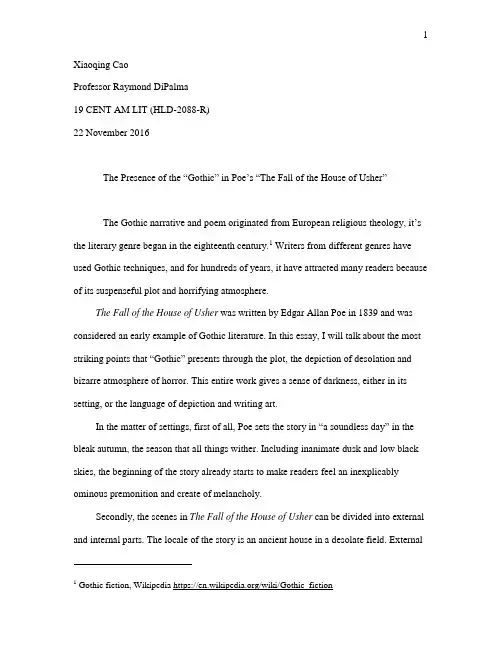
Xiaoqing CaoProfessor Raymond DiPalma19 CENT AM LIT (HLD-2088-R)22 November 2016The Presence of the “Gothic” in Poe’s “The Fall of the House of Usher”The Gothic narrative and poem originated from European religious theology, it’s the literary genre began in the eighteenth century.1Writers from different genres have used Gothic techniques,and for hundreds of years,it have attracted many readers because of its suspenseful plotand horrifying atmosphere.The Fall of the House of Usher was written by Edgar Allan Poe in 1839 and was considered an early example of Gothic literature. In this essay, I will talk about the most striking points that“Gothic” presents through the plot, the depiction of desolation and bizarre atmosphere of horror. This entire work gives a sense of darkness, either in its setting, or the language of depiction and writing art.In the matter of settings, first of all, Poe sets the story in “a soundless day” in the bleak autumn, the season that all things wither. Including inanimate dusk and low black skies, the beginning of the story already starts to make readers feel an inexplicably ominous premonition and create of melancholy.1 Gothic fiction, Wikipedia https:///wiki/Gothic_fictionSecondly, the scenes in The Fall of the House of Usher can be divided into external and internal parts. The locale of the story is an ancient house in a desolate field. External refers to the environment: “I looked upon the scene before me —upon the mere house, and the simple landscape features of the domain —upon the bleak walls —upon the vacant eye-like windows —upon a few rank sedges —and upon a few white trunks of decayed trees…” This plain environmental description obviously reflects the author’s own sensitivity, so that even as a reader, I have been infected with the dreariness.“The room in which I found myself was very large and lofty. The windows were long, narrow, and pointed, and at so vast a distance from the black oaken floor as to be altogether inaccessible from within.” These words describe a gloomy and dim atmosphereinside the house as well, and I associate the images with the horrible and strange things that might happen there.The third crucial point in the settings is the same mental confusion, which is varying degrees of insanity that three characters in the story all have: Roderick, narrator’s friend, seems to be aware of his mental abnormality and tries to regain consciousness, which can be seen in “The writer spoke of acute bodily illness …—and of an earnest desire to see me, …by the cheerfulness of my society, some alleviation of his malady.”Madeline, his sister, has accepted her mental problems and continues to lives on, “Hitherto she had steadily borne up against the pressure of her malady, and had not betaken herself finally to bed.” The narrator finally becomes a participant in the mental breakdown of theUsher family. “… in which wonder and extreme terror were predominant, I still retained sufficient presence of mind to avoid exciting…” Although he has been suppressing his fears, in the end, he flees the house in a panic. To considerRoderick’s goal is to reassure himself, on the contrary, he pushes himself to death, the plot is assuredly dark and zigzag.In terms of the art language, as I mentioned above, just the opening of the story is sufficient to cause a sense of horror. An opening is importantbecause it directly affects the readers’ experience and knowledge, through the alternate use of environmental description and psychological descriptionin Poe’s writing.Poe repeatedly mentions the fear, panic and superstition in the mind of the narrator. The narrator doesn’t like the ancient house, he comes because “a letter from him —which, in its widely importunate nature, had admitted of no other than a personal reply.” I think Poe demonstrates greatskill in using the reiterative sentences. He also combines Gothic theory with reason and craziness, uncanny atmosphere and reality. Regarding to the narratorwho keeps repeating and distinguishing whether it is a dream or not while he is on the way to Usher’s house.In general, the language of Gothic style writing is obscure and repressive. More straightforwardly, it is full of excessive description of the innate fear of human beings. House of Usher is also filled with a stifling sense of horror. It’s undeniable that Edgar Allan Poe is the master of Gothicliterature, he uses the pessimistic romantic style of literary expression to ponder and explore the eternal theme of spirit.。

不稳定人物、非家的家、活着的死亡—爱伦坡哥特式短篇小说中的“暗恐”埃德加·爱伦·坡(Edgar Allan Poe,1809-1849)是十九世纪美国著名的诗人,文学评论家和短篇小说家。
他的短篇小说充斥着古堡、死亡、谋杀、超自然力量等传统的哥特式元素并给小说人物和读者带来恐惧,但这种恐惧不再是外部的而是心灵内部的。
本文通过弗洛伊德的暗恐理论,对三个二元对立现象:不稳定人物、非家的家、活着的死亡进行了深入分析,以期为坡哥特式小说的心理解读提供一个新的视角。
本文可以分为三个部分:第一部分为论文的导入部分,该部分对爱伦坡、其三部哥特式小说、这些作品国内外研究现状及弗洛伊德的暗恐理论进行了简要介绍。
第二部分为论文的讨论部分。
第一章从人物呈现的不稳定性入手,该论文发现主人公都经历着暗恐,其暗恐感受来源于“复影”和由于无力感唤起的“阉割情结”。
正是由于这些暗恐经历,导致了主人公的不稳定性。
第二章探究家的非家性。
这篇论文指出家成为了主人公的暗恐之地并阐释了爱伦坡笔下的家不再是建筑本身,而是人物心理的“复影”。
第三章分析活着的死亡。
论文指出主人公都谋杀了他人。
实质上,他人作为主人公的复影是主人公压抑的本我或超我。
由于本我和超我之间的矛盾,主人公把其中一者压入无意识。
而被压入无意识的部分可以进入意识,所以被压抑物可以再次出现并给主人公带来暗恐感受。
在这三篇短篇小说中,这体现为被谋杀者死后对谋杀者的影响。
第三部分为结论部分。
暗恐来源于压抑,而压抑物的复现又会导致主人公的再一次暗恐。
通过研究文本中呈现的三个二元对立,该论文解读了坡的心理书写,揭示了坡笔下主人公的心理病态是来自于自我压抑。


《“红死”的假面舞会》的哥特式恐怖赏析-最新文档《“红死”的假面舞会》的哥特式恐怖赏析一、引言哥特体小说在文坛上时间很短,杰出的作品也并不繁多。
哥特体小说的突出特点便在于它的四大要素,即悬念、神秘、魔幻和恐怖。
哥特体小说常见的主题多为乱伦、死亡、隔绝等。
爱伦坡擅长写“哥特式”风格的作品,人物怪异、颓废、病态、惊悚,故事情节令读者感到颤抖、崩溃。
《“红死”的假面舞会》就是一部典型的哥特式作品,在作品中爱伦坡继承和发展了“哥特式”的手法。
本文将从哥特式人物、神秘恐怖氛围的营造、哥特式题材来赏析这部作品的恐怖美。
二、故事简介故事采用第三人称叙述,描述了一场假面舞会。
有一种叫做“红死”的瘟疫非常猖獗,为了躲避“红死”病,普洛斯彼罗亲王召集了一千名身体健康的骑士,住到一座城堡里去,并在进去之后,把所有门闩都焊上了。
任何人都无法进来或出去。
一次假面舞会上,在午夜钟声敲响之际,“红死”突然神秘出现,在场所有的人无一幸存,统统摆脱不了死亡的命运。
故事虽然短小,但是渲染出浓浓的恐怖情绪。
三、哥特式恐怖分析(一)哥特式人物既然哥特小说又是鬼怪小说,那么哥特小说中所要主力表现的重要内容自然少不了鬼怪形象。
不过,哥特小说一般不以鬼怪形象作为作品的主要形象,它们的主要作用是为哥特小说中的人物活动营造出神秘的气氛、怪异的环境,引发恐怖的感觉。
另外,小说中还会通过幻想让小说中的人物使用魔术与魔鬼幽灵产生联系,并借它们的帮助来达到贪婪、野心和肉欲的目的。
[1]P516假面舞会实际上是在西方万圣节时人们经常举办的活动,参加舞会的人们装扮成各种妖魔,赶走游荡在四周的妖魔鬼怪,所以,整个假面舞会的狂欢者都是稀奇古怪的造型。
在作品《“红死”的假面舞会》中,舞会对装扮形象是没有限制的,可是有个陌生人却在假面舞会上装扮成“红死”。
“他的服装在血中浸泡过,他宽宽的前额以及整个五官都撒满了红色恐怖。
”[2]P143此人的装扮显然是“红死”病的征兆。
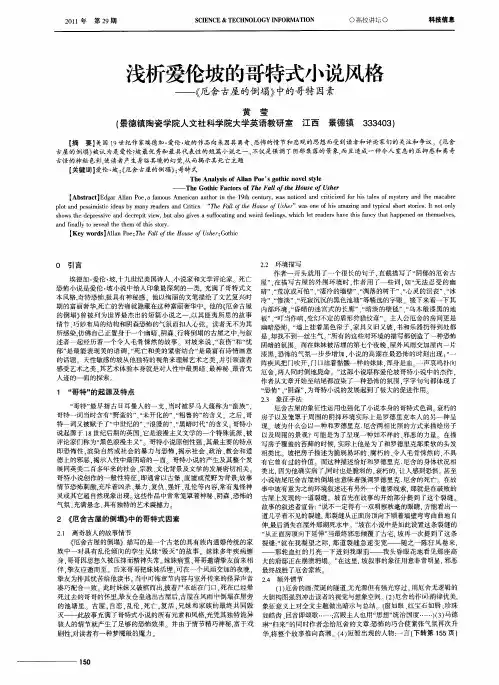
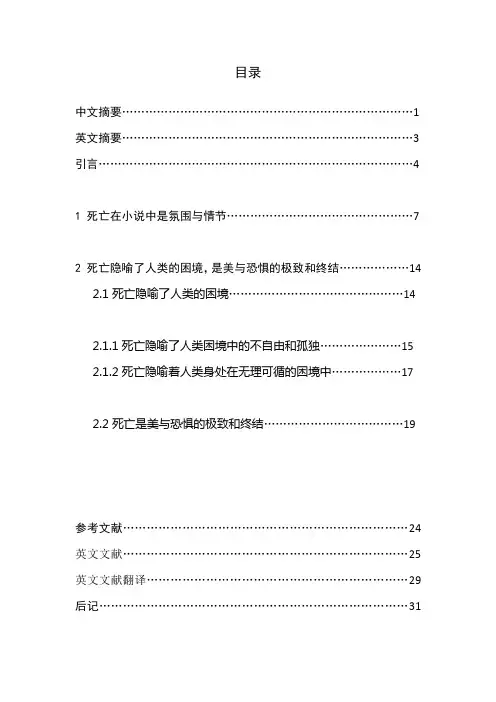
目录中文摘要 (1)英文摘要 (3)引言 (4)1 死亡在小说中是氛围与情节 (7)2 死亡隐喻了人类的困境,是美与恐惧的极致和终结 (14)2.1死亡隐喻了人类的困境 (14)2.1.1死亡隐喻了人类困境中的不自由和孤独 (15)2.1.2死亡隐喻着人类身处在无理可循的困境中 (17)2.2死亡是美与恐惧的极致和终结 (19)参考文献 (24)英文文献 (25)英文文献翻译 (29)后记 (31)浅析爱伦坡短篇小说中死亡主题的内容和意义摘要埃德加.爱伦.坡,美国文学史上不可磨灭的天才式人物,以其隽永的文学创作和悲剧式的人生命运闻名于世,一直以来,学界对他的了解和研究,和其本人的性格一样,一直与潮流保持着若即若离的关系。
第一章第一节死亡作为情节和氛围出现在小说中在《厄舍府的倒塌》中,死亡出现在文章的中间和末尾,中间的“死亡”(假的死亡)发生在作为作者“从小就是好朋友”但“许多年未曾谋面了”的罗德里克·厄舍的妹妹玛德琳小姐身上:“有一天晚上,他忽然告诉我,玛德琳小姐去世了,他说他打算把她的尸体放进古厦的地窖中保存两个星期,再举行葬礼。
”(人们文学出版社2003年《爱伦坡短篇小说集》,P51)在这里,死亡作为故事的一个中途情节,对小说的情节起着一个承上启下的作用:在小说的起初,就为我们展示出一种颓败、阴暗的局面:“在这年秋天的一个沉淡、阴暗、寂静的白日,天上的云彩低垂。
……暮色降临时,我终于看见了那阴沉的厄舍古厦。
……我望着前面的景象——望着这幢房子和它周围的地貌,望着光秃秃的墙壁,望着眼睛般的窗户,望着那一排排蓑草,望着那几株死树的白树干,……这样一想,我便策马来到池塘陡峭的边缘,观看灰色的蓑草、丑陋的枯树干,和那眼睛般空洞洞的窗口,我心中忽然打一个冷战,情绪变得比刚才更为压抑。
”(人们文学出版社2003年《爱伦坡短篇小说集》,P51)进入厄舍府后,厄舍的坏境同样是使人隐忧的:“使自己相信古厦及其周围的地区笼罩着一种特有的气体,这种气体与天上的空气不一样,它是从朽树、灰墙和宁静的池塘中溢出来的,是一种神秘的毒气,压抑、惰滞、蒙蒙的可以看到,呈铅灰的颜色。

浅谈爱伦·坡作品中哥特式创作手法体现龙源期刊网/doc/2905166c091c59eef8c75fbfc77da26 925c59669.html浅谈爱伦·坡作品中哥特式创作手法体现作者:李翠萍来源:《青年生活》2019年第14期摘要:埃德加·爱伦·坡(1809—1849)作为美国哥特式文学的开拓者,十分娴熟地将怪诞、恐怖和离奇元素运用在作品中,以其独特的风格和引人入胜的小说情节,在美国文坛占据一席不朽之地。
爱伦·坡并不默守陈规,而是在传统写作基础上进行创新,“用演绎心灵恐怖的创作手法提升了哥特小说的艺术地位”。
[1]本文通过对其作品《黑猫》的表现手法进一步分析探寻爱伦﹒坡小说哥特式的体现。
关键词:爱伦·坡;黑猫;哥特式《黑猫》中的意象在作者爱伦·坡的众多作品当中,动物大多都带有意象色彩。
在小说《黑猫》中,黑猫这个动物角色设计可以说是作者的独特匠心。
究其文化背景,黑猫在欧洲文化中被掺杂着神秘的色彩,大多数被看作是邪恶的女巫的宠物,认为黑猫会带来厄运和不幸。
因此,爱伦·坡利用此神秘而邪恶的意象增强作品的恐怖哥特效果,读者读前就能在脑海中形成一种恐怖的预期。
第一只黑猫名叫普路托,“普路托”是古希腊神话中地狱的统治者冥王的名字,是死亡之神,常常被后人用来指代神秘、阴森的形象[2]。
但是,第一只黑猫普路托并不是完全“邪恶”的代表。
主人公原本和性格相似的妻子一起喂养了普路托,在此处主人公与普路托的关系是和谐的。
剧情随后进行变化主要是因为主人公染上酗酒的恶习,在一次酩酊大醉后因黑猫的反抗而挖掉它的一只眼睛。
“一天早晨,我心狠手辣,用根套索勒住猫脖子,把它吊在树枝上,眼泪汪汪,心里痛悔不已,就此把猫吊死了” [3]。
从开始将普路托眼睛挖掉到最终被吊死,可以观察到主人公害怕直视黑猫的眼睛,怕被其参透黑暗的内心,究其原因是恐惧。
而第二只黑猫象征着的意味不仅是黑猫的复仇,更是一种人性深处的自我审判意识。
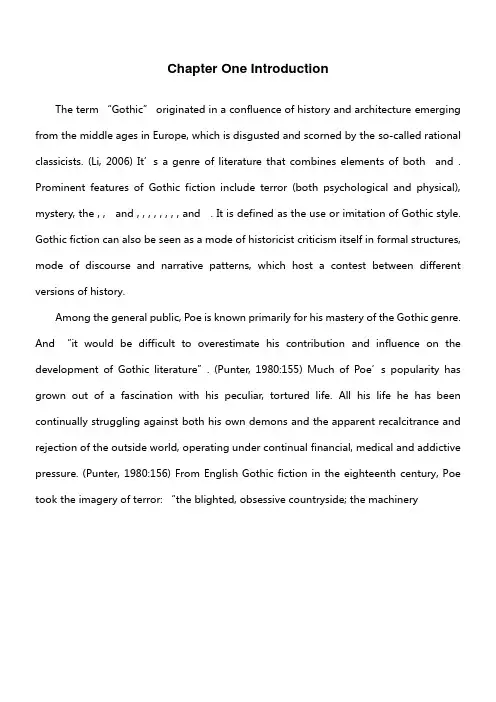
Chapter One IntroductionThe term “Gothic” originated in a confluence of history and architecture emerging from the middle ages in Europe, which is disgusted and scorned by the so-called rational classicists. (Li, 2006) It’s a genre of literature that combines elements of both and . Prominent features of Gothic fiction include terror (both psychological and physical), mystery, the , , and , , , , , , , , and . It is defined as the use or imitation of Gothic style. Gothic fiction can also be seen as a mode of historicist criticism itself in formal structures, mode of discourse and narrative patterns, which host a contest between different versions of history.Among the general public, Poe is known primarily for his mastery of the Gothic genre. And “it would be difficult to overestimate his contribution and influence on the development of Gothic literature”. (Punter, 1980:155) Much of Poe’s popularity has grown out of a fascination with his peculiar, tortured life. All his life he has been continually struggling against both his own demons and the apparent recalcitrance and rejection of the outside world, operating under continual financial, medical and addictive pressure. (Punter, 1980:156) From English Gothic fiction in the eighteenth century, Poe took the imagery of terror: “the blighted, obsessive countryside; the machineryof the Inquisition; in particular, the haunted castle, swaddled in its own atmosphere of morbidity and decay”. (Carlson,1987:127) Being a literary talent born, Poe has high sensitivity, “with an intuitive faculty of imagination and a subtle sixth sense impossible to define”.(Chang, 1999:152) At the age of 18, he published his first volume of poems Tamerlane and Other Poems. Poe has been trying to make a living by writing and won his fame through devoting himself as an editor for various magazines or newspapers, short tales writer, poet and literary critic. However, no wealth came to him out of all this at all--poverty remains his typical condition towards his last years. The most controversial criticism has been passed on his works as well as his person. More than a century and a half after his death, critics have not come to any settled opinion over the merits of his individual style. They were reluctant to come to terms with Poe and failed to do full justice to his genius. Absolutely it is a pity that most of Poe’s fellowmen, especially those who were in his time, failed to realize his value or appreciate his genius, while what is worse is that he has been blasphemed with the most spiteful vilification. In any cases, it is no fair judgments long after his death. Reverend Rufus Griswold, whom he had the unfortunate idea of appointing his literary executor, branded Edgar Allan Poe a neurotic person, a drunkard and drug addict “who walked the streets,in madness or melancholy, with lips moving in indistinctcurses.”(Clarke, 1998:41)American modernist writers claim that “an enthusiasm for Poe (was) the mark of decidedly primitive stage of reflection”. (Clark, 1998:209) While it is awfully strange that in European countries (and among a small portion of America), Poe has won the respect and admiration no less tough in degree than the misunderstanding or inveigh he has been opposed at home. For Baudelaire, he was a “fallen angel who remembered heaven,” a “Byron gone astray in a bad world”. (Clarke, 1998:41) Yeats sang high praise for him, regarding him as “so certainly the greatest of American poets, and always, for all lands, a great lyric poet”. (Clarke, 1998: 41) With the growing study and research in Poe’s works and his personality, the modern tendency witnesses an increasing popularity and appreciation that justify his significance and contribution. It is progressively convinced by the modern critics that Poe is one of the greatest literary figures in the ., who has fathered many things, one of which is the detective stories, and the other being psychoanalytic criticism that is quite available for the interpretation of his Gothic tales. (Chen, 2007) Many authors, either American or European, such as . Eliot, William Faulkner and Conan Doyle, all confessed owing a good deal to him. Poe’s Gothic stories are enduringly arresting and everlastingly haunting, pervading his uniquely grotesque taste and morbid idiosyncrasy. In his own words, the sole effect of terror that hisperformance in composition achieves “comes not from Germany, but from the soul”. (Carlson, 1987:127) Consequently, most of Poe’s tales devolve from Gothic tradition, and supernatural horror pervades his short stories. He explores terror from where it is originated and functioned further into the mind. His achievements win him the eternal position in the literary world of all ages, and his genius and talent are gaining an increasing appreciation and popularity.Following the brief discussion of the term “Gothicism”and the literary review on Edgar Allan Poe in the Introduction, the second chapter traces the Gothic tradition in English literature, and the traditional characteristics of Gothic literature. Chapter three discusses the inheritance of “Gothic” in Poe’s tales in two parts. It’s mainly about the influence from the British Gothic novel and American literature tradition. Chapter four treats with Poe’s innovation of the terror tale from what had been its principal intent, to use a widely current phrase of the times into what have been recognized as some of the most sophisticated creations in psychological fiction in English language. Chapter five copes with the unique and rich features represented in the three stories: The Black Cat , The Fall of the House of Usher and The Masque of the Red Death.The conclusion part brings the whole thesis to an end and points out through the five chapters discussed above that Gothicism isprofoundly improved and explored in Edgar Allan Poe’s short stories. It also articulates Poe’s uniqueness a nd significance, which renders him the growing popularity in the literary world. Edgar Allan Poe’s accomplishments share the universal appreciation and fondness for the value and success.Chapter Two The Gothic Tradition in EnglishLiteratureThe genesis of term “Gothic”As a genre, it is generally believed that the term “Gothic”is invented by the English author , with his novel . In the next sixty years, Gothic literature dominated the literary scene.Gothic literature makes readers start to behold the great emotions that writers could evoke. It has several distinguishing features. As readers consumed texts with the supernatural and the horrific, they also tended to love that sensation that the suspense brought out. Gothic literature is melancholy. It contains elements of darkness and mystery and is often overly dramatic. The Gothic creates feelings of gloom, mystery, and suspense and tends to the dramatic and the sensational, like incest, diabolism, and nameless terrors. It intended to awaken the readers’ imagination. Terror is one of the main devices employed for this effect.Gothic literature is intimately associated with the of the same era. In a way similar to the Gothic revivalists’rejection of the clarity and rationalism of the style of the Establishment, the literary Gothic embodies an appreciation of the joys of extreme emotion, the thrills of fearfulness and awe inherent in the , and a quest for atmosphere. According to many critics in terms of psychological argument, Gothic literature is the product of repressed fears represented in textual form, perhaps because of the concentration of critical activity. The Gothicremains a notorious difficult field to define.In literary sense, it is clearly possible to speak of the Gothic as a historical phenomenon, originating in the late eighteenth century.(1980) Since 1970s, the Gothic has become a highly popular field in academic study. Many books both on the Gothic in general or particular subgenres and on authors have been published.The nature and development of Gothic traditionGothic literature got its start in 1764 when Horace Walpole wrote The Castle of Otranto. Afterwards, there teemed numerous world-wide celebrated Gothic fictions, among which are The Mysteries of Udolpho by Ann Radcliffe, The Monk by Mathew G Lewis, Frankenstein by Mary Shelly, Tales of the Grotesque and Arabesque by Edgar Allan Poe and so on. The vital factor rests on the challenge against Rationalism by Romanticism.The emergence and flourish of the Gothic fiction in the eighteenth century have particular roots in the aspects of society, history and culture. Walpole’s story contains all the elements that define the genre. Throughout the years, many authors have taken their stab at writing Gothic literature, putting their own unique stamp on it. Ann Radcliffe, writing in 1794, gave the genre a sense of legitimacy when she questioned the supernatural elements, explaining them away as naturalcauses. She also introduces the brooding villain. Mary Shelley, the author of Frankenstein, is definitely influenced by Gothic elements, though her novel is considered the one of the first science fiction novels to be written. Emily Bronte’s Wuthering Heights, explored Gothic elements on the Yorkshire Moors through the brooding “Heathcliff”character. It is still a favorite today. With Bram Stroker’s “Dracula” the most famous Gothic villain ever is created. He also established Eastern Europe as a favorite locale for the genre. More recently, in the 1930’s, . Lovecraft has been connected with the genre, blending the Gothic with horror, setting a new bar for writers. (Mary, 2005)Another influential author in the Gothic tradition is Edgar Allen Poe. He is an important and innovative commissarial of the Gothic in this period, who believed that terror is not of Germany, but of the soul. Poe’s debut on the literary scene is in the 1820s and 1830s, and continuing long after his death in 1849, sense of horror enlivened Gothic productions. Since .Lovecraft puts that the most ancient and powerful feeling of the human being is the sense of terror, while if it is too realistic. He explores such classic Gothic themes of decay, death, and madness, but he added his own twist-- he looked into the terrors of the soul.Romance has also been mixed with the Gothic genre. During the 1950’s to 70’s, such authors as Victoria Holt and Dorothy Fletcherfocused on the female and her connection to a gloomy castle. Another sub-genre is known as Southern Gothic. This sub-genre takes traditional Gothic elements and plants them in the Southern United States to have a novel known as “Gothic”. First, the setting takes place in a castle, the story is set in America, an old family estate. That’s what makes Southern Gothic so appealing, because an old plantation can be used. The estate, be it a castle, mansion, or plantation, can sometimes be abandoned, sometimes occupied, or it can be near caves to augment a mystery and may often contain secret passages, trap doors, and mysterious rooms. Next, the novel has to carry an atmosphere of mystery and suspense.In so far, the Gothic is perceived as the source and repository of some of the unique, valuable and essential elements in English culture. A prevalent tendency to depend less on the supernaturalism of European Gothic tradition and to employ more psychological substance is evident. Granted, some Americans continued to draw upon what we might define as “straight” supernaturalism to enhance their Gothic productions.Chapter Three The Inheritance of “Gothic” inPoe’s WorkEdgar Allan Poe, as one of the figures in American Southern literature, has made important contribution to the development of the Gothic literature. At the same time, the heritage he sucks from the Gothic tradition construct the creation of so many excellent fictions. This chapter will briefly introduce Poe’s literature status. And he isinfluenced by the British Gothic novel and American literature traditions.. The influence of the British Gothic novelIn Poe’age, English Gothic writers often associate medieval buildings with what they see as a dark and terrifying period. (Cheng, 2007) They often characterize by harsh laws enforced by torture, and with mysterious, fantastic, and rituals. Literary works are no longer only found in the aristocratic family, for they begin to have middle and under--class readers. It often incorporates older or traditional plots, and it has appealed to fantastical or supernatural events, which cannot be justified or analyzed by empirical or rational methods. Instead of singing high praise for the virtues or exhibiting the smiling aspects of the society, Gothic fiction depicts psychological and social dilemmas and demonstrates the potential revolution by daring to speak the socially unspeakable, although the very act of speaking is an ambiguous gesture. (1980) The Gothic as a style of novel set its unarguable position in British literature, and also influenced literature in other countries, especially in America and Germany.Edified by the British literature, Poe likes to read British Gothic novel. So when writers create their stories they have to take the taste of the readers into consideration. Poe is not an exception for his livelihood.He makes a research and finds that people are extremely interested in the Gothic novel which is full of horror and grotesquery. Many of Poe’stories take place in the Gothic environments, such as the declining aristocratic family or graves full of dead bodies. When reading Poe’s short stories, the readers are not only impressed by the weird characters, but also greatly stroke by the hair-raisingly mysterious and somber atmosphere. Gothic scene is an important ingredient representing its dark feature for Gothic tales. The traditional Gothic settings and props of gloom are generally located in ruined castles and abbeys, murky crypts and fungous, dark passages and stairwells echoing with howls, groans and dripping charnel houses, derived from the Gothic architecture, which flourished in the twelfth to the sixteenth century. In many of Poe’s works, setting is used to paint a dark and gloomy picture in our minds. Its stereotypical characteristic involves high-pointed towers and narrow windows with indistinct panes, usually dark inside, so that the reader can make a connection between darkness and death. In his stories, the Gothic medieval religious excruciation and crazy killing in revenge are the common plots, and the characters are always pale, seriously ill or mentally depressed and hysteria. Poe’s Gothic fiction inherits the environment setting mode in traditional British Gothic novel. The stories happen in a closed and isolated space, which will not let the readers associate with their own ages. He creates anew world, in which his readers will concentrate on the plot or atmosphere of the story. Poe believes that the finest art exists in a world different from one’s own. In order to create such a world, an ambiguous time background is needed so as to bring the readers into a wonderful world that is far away from their everyday life. Poe’s story sometimes takes place in at an unknown place such as in The Fall of the House of Usher, or in some large, old, decaying city near the Rhine such as in “Ligeia”. In another word, his story seldom happens in a recognizable place. The characters in his works have not a name or sometimes just are given a name randomly. What is emphasized by Poe is the final effect of this personal creation and its emotional function. Gothic setting and situations have maintained their popularity in Poe’s works.The influence of American literature traditionIn America, the Gothic impulse also strongly throbs yet is manifested in another pronounced feature-the psychological possibilities, a strong thread began with Brown, through Poe, Hawthorne, Henry James, and still powerfully at work in Southern Gothic of the twentieth century. Another great writer of American Gothic fiction in the nineteenth century is Hawthorne. While Poe vehemently rejects didactic literature, Hawthorne is concerned withmoral problems--sin and guilt everywhere. But what Poe argues for his writing that “my terror is not of Germany, but of the soul”(Poe, 1971:8) may as well be applied to analysis of Hawthorne’s fiction since the moral problems as also the problems of human personality, and to a great extent, psychology. Besides the exploration and expression of the aberrant human psychology, another contribution of the American Gothic fiction to the Gothic literature in this century is to extend it from the dominant novel to the short story. Compared with the loose structure and often too digressive subplots of the early Gothic novel, the tightly coherent structure and strong intensity of American short story, perfected in the works of Poe and Hawthorne, and inherited successfully by Bierce and enriched by Faulkner and O’Connor, demonstrate a new power of the Gothic. (Mary, 2005) In short, the Americanization of the Gothic, the exploration of dark psychology and the flourishing of Gothic tales show that American Gothic is more than an offshoot of the English Gothic. The indigenous American Gothic presents destructive forces that do not exist in European experience.As an American writer, Poe is deeply affected by local American literature. American Gothic fiction is nurtured from the mysterious and horrible south soil. The tradition of grotesquery made American writers create numerous grotesque groups. The painful heart and tragic life of southern American people are demonstrated. The southern literarytradition can be traced back to Brown and Poe’s Gothic works. Many critics notice the similarity between Faulkner and Hawthorn. Poe as a southerner and the ancestor of modernism is even closer to the mentality of writers like Faulkner. Without the intangible seed that Poe had planted, there is no possibility for the blossom if the grotesque novel of Faulkner. Poe is a malformed production of a malformed society, so his Gothic fictions digging into the morbid psychology and describing the abnormal behavior are the reflections of his own freaky psychological feeling.Because of the particularity of the history of the south, Edgar Allan Poe enters modern age, witnessing the changes and declining of the society. He evolves a unique study of human guile and cruelly from the American Gothic fiction. Experiencing multiple conflicts and painful torture, it discovers observantly the disaster brought by capitalism and the distortion to human nature. The southern Gothic fiction reflects Poe’s meditation. As one of the most essential response of the Gothic tradition, Poe has to dig for the food his rapidly expanding intellect requires. Not surprisingly, his appetite has, to some extent, turned inward and he is forced to feed upon himself.Chapter Four The I nnovation in Poe’s Gothic Tales Poe’s short st ories are charming and enduring. It owes much to his unique Gothic techniques apart from the Gothic tradition. He deserves to be the master of manufacturing terror achieved by the utilization of the skills of the psychological analysis, the narrator, and the symbolic accent. The adoption of the writing style is carried on even by the contemporary authors. Poe’s distinctive technique of probing deeply into the human consciousness and subconsciousness is effectively employed in his Gothic tales.The psychological analysisSince the late 19th century, the advance of analytic psychology provides literature with a vocabulary and frame of reference for interpreting Gothic writing from a humanistic point of view. (Li, 2020) One of Poe’s greatest literary achievement is his innovation of the terror tale from what have been its principal intent, to entertain by means of “curdling the blood”,to use a wildly current phrase of the times, into what have been recognized as some of the most sophisticated creations in psychological fiction in the English language. He realizes at the outset of his career that Gothicism is eminently compatible with psychological plausibility in literature, and he worksout such designs in combination repeatedly throughout his literary career.Since mentioning the psychological analysis, we must remember a person--Sigmund Freud. All of Freud’s work depends upon the notion of the unconscious, which is the part of the mind beyond consciousness which nevertheless has a strong influence upon our actions. The unconscious is a storehouse of those painful experiences and emotions, those wounds, fears, guilty desires, and unsolved conflicts we do not want to know about because we will be overwhelmed by them. Considering Poe’s own experiences, it is easy to find out that mental process of the narrator in his fictions is exactly the projection of Poe’s mental process. Poe unconsciously foreshadows the method of psychoanalysis in his works. Linked with this is the idea of repression, which is the “fo r getting”or ignoring or unresolved conflicts, unaccepted desires, or traumatic past events, so that they are forced out of conscious awareness and into the realm of the unconscious.In both literature and art, Poe’s Gothic tales principally represent psychic disintegration. It can also manifest the potential of positive integration and growth in the process of identification. The tales are about the dangers of neglecting or even repressing the unconsciousness in the process of identification. If heeded, the unconsciousness can prove positive to responsive characters becomingcurative and creative and promoting identification. If ignored, however, the unconsciousness turns negative and destructive.Psychological states are major elements in Poe’s Gothic tales.In applying the idea on identification to The Fall of the House of Usher, we find that the narrator tells a nightmare of psychic disintegration caused by the repression of the unconsciousness. From the psychological perspective, this tale can be read as a wakeful dream of the narrator. It is a journey into the depth of the self. The central subject is the human mind in a great continuous condition of disintegration. The nightmarish disintegration hints a theme of encountering of self unconsciousness with dream figures who are dominated by intellectual rationality and risks psychological breakdown. The tale represents stunted process of identification by personifying the narrator as the dream self, with the Ushers, the two parts of a single person, as his shadow, Roderick as his consciousness interrupted by unconsciousness, and Madeline as his unconsciousness. Even though the tale ends with images of Gothic disintegration, it does not ultimately illustrate an unsuccessful attempt to escape from a regressive state of psychic disintegration.The narrator: identification with the selfMany American writers before Poe tend to use the third person point of view in the works, but Poe likes very much to use thenarrator’s point of view. When the narrator depicts the heart-quake story he has experienced, he will narrate his thought and behavior as objectively as possible. Not accidentally does Poe give us a tale of disintegrating bodies, but, more important, disintegrating psyches as well, which he constructs with a mansion that looks like a human head. Granted, that “head”is grotesque in its corporeal appearance, but once again Poe directs our closer attention to what lies inside. Usually it seems to take place outdoors, but what is the precise geographical location of “a singularly dreary tract of country”(Poe, 1982:138) traversed by the narrator on horseback. I submit that even at this initial stage Poe is establishing geography of the imagination. At the House of Usher the narrator found himself, a loaded phrase which in context with the variation on “house”,helps to establish a psychological emphasis within the tale, no matter what outward Gothic trappings lie at the surface.The narrative technique through Poe’s stories is: the first person point of view narrator uses a recreate--experience syntax to narrate his story and make the readers become the principle part of the story. The narrator seems to see and think, but “I”disappear in the rhetoric structure. The reader find that they are facing directly is their own subjective impression. The early Gothic fiction writers influence the readers by describing the horrible experience directly, but Poe adoptsthis indirect method as a more skilled way to arouse the readers’enthusiasm: the key of this method depends on directness--through which directness the readers take the response of the narrator as their own response.Here is an example: the narrator “I” in the The Tell-Tale Heart is a jittery madman, “I” kills an innocent old man just because “I” can not bear the “vulture like eyes” of the old man. The story describes in great detail how “I”spends eight days scouting the old man at every midnight and family kills him, burying the body under the floor. In order to romance the unique mystery and horror of the morbid psychology in the process of killing, Poe depicts the blue light of the vulture eye under feeble midnight and the heart beating of the old man. The devilishness of the vulture eye and the louder heart beating are just the self feeling of the madman. The policemen do not hear the heart beating (we should say there is no sound of hearting beating at all), it is just the illusion of the criminal produced by dread or the condemnation of conscience. But the stimulation of the heart beating to “I” is bigger and bigger so that “I” can not bear the torture any more and shriek with madness. Poe depicts the psychological feeling of a morbid character, and passes this feeling to the readers to create the horrible atmosphere so as to achieve the author’s expects.The narrator represents the self, and the narrator undergoes aprocess of psychic disintegration, the unconsciousness, which represents his impulse of free imagination in art creativity, alive. He uses a recreate-experience to narrate his story and make the readers become the principle part of the story. In having returned to consciousness and the self-conscious role of the narrator, he has gained the perspective to make his Gothic nightmare of psychic disintegrating a forever memory and to let it affect his personality. His emphasis on what he remembers indicates that his dream has wakened him to new understanding. He has strengthened the psyche through controlled, creative contact with the unconsciousness. He is the very “eye” reporting on a special scene and giving the readers a restricted view of the surroundings in which he finds himself.Symbolic accentPoe’s another significant writing style is the symbolic accent, in which the use of symbols and omens are unique in his Gothic genre. The symbolic accent is effectively performed in his tales. In the most literal sense, all language is symbolic. Symbolism refers generally to the systematic use of symbols in order to represent or allude to something. It is an important element of most religions and the arts. Although it is in several decades when the symbolism becomes a literature movement, Poe pioneers this kind of writing style by endowing particular images orobjects with symbolic meaning in his fictions to clothe the ideal in a perceptible form, and his works, have a significant influence on and are the source of many stock tropes and images.Fletcher has ever puts that, comparing to Hawthorne, the other great symbolist in the early nineteenth century, whose symbolism depends on sight, Poe’s symbolism“depends on sound”. (Poe, 1971:52) Yet I would like to argue that Poe’s symbolic accent rests on object as well as sound and sight. Besides the beating of the hideous heart in The Tell-tale Heart, we are easily reminded of the dreadful ebony clock and untenanted figure in The Masque of the Red Death. Although Poe might keep scorning the symbolistic device as a “trick”, there comes the only agreeable conclusion by almost all the critics on him that he remains a symbolist. Along with the remarkable symbolistic accent in The Masque of the Red Death that we have earlier discussed, The Black Cat is also another eloquent justification of his fame for his allegorical-symbolic style. In ancient Greek myths, black cat is the symbol of the evil and the mysterious; in European legends, black cat is even seen as the avatar of witch with some vicious and supernatural power. The allegorical appellation of The Black Cat“Pluto”, which is the name of the King of Terrors or the dominator of the hell in the ancient Greek myth, endues with the fiction a profound symbolistic hue of the uncanny, horror and crime. Consequently, The Black Cat has。
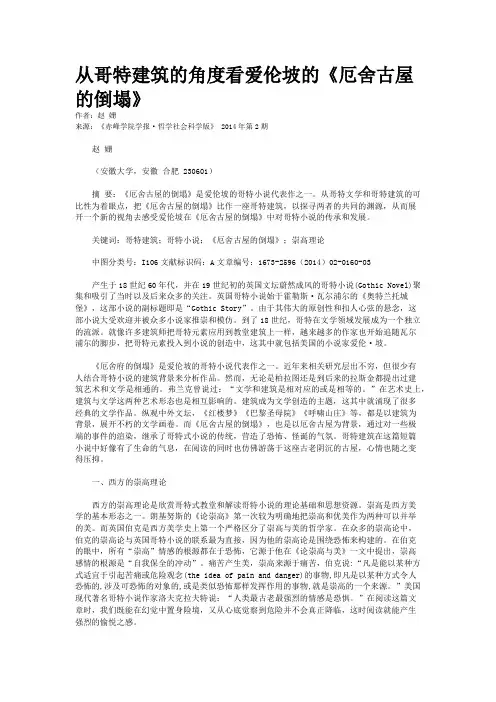
从哥特建筑的角度看爱伦坡的《厄舍古屋的倒塌》作者:赵姗来源:《赤峰学院学报·哲学社会科学版》 2014年第2期赵姗(安徽大学,安徽合肥 230601)摘要:《厄舍古屋的倒塌》是爱伦坡的哥特小说代表作之一。
从哥特文学和哥特建筑的可比性为着眼点,把《厄舍古屋的倒塌》比作一座哥特建筑,以探寻两者的共同的渊源,从而展开一个新的视角去感受爱伦坡在《厄舍古屋的倒塌》中对哥特小说的传承和发展。
关键词:哥特建筑;哥特小说;《厄舍古屋的倒塌》;崇高理论中图分类号:I106文献标识码:A文章编号:1673-2596(2014)02-0160-03产生于18世纪60年代,并在19世纪初的英国文坛蔚然成风的哥特小说(Gothic Novel)聚集和吸引了当时以及后来众多的关注。
英国哥特小说始于霍勒斯·瓦尔浦尔的《奥特兰托城堡》,这部小说的副标题即是“Gothic Story”。
由于其伟大的原创性和扣人心弦的悬念,这部小说大受欢迎并被众多小说家推崇和模仿。
到了18世纪,哥特在文学领域发展成为一个独立的流派。
就像许多建筑师把哥特元素应用到教堂建筑上一样,越来越多的作家也开始追随瓦尔浦尔的脚步,把哥特元素投入到小说的创造中,这其中就包括美国的小说家爱伦·坡。
《厄舍府的倒塌》是爱伦坡的哥特小说代表作之一。
近年来相关研究层出不穷,但很少有人结合哥特小说的建筑背景来分析作品。
然而,无论是柏拉图还是到后来的拉斯金都提出过建筑艺术和文学是相通的。
弗兰克曾说过:“文学和建筑是相对应的或是相等的。
”在艺术史上,建筑与文学这两种艺术形态也是相互影响的。
建筑成为文学创造的主题,这其中就涌现了很多经典的文学作品。
纵观中外文坛,《红楼梦》《巴黎圣母院》《呼啸山庄》等,都是以建筑为背景,展开不朽的文学画卷。
而《厄舍古屋的倒塌》,也是以厄舍古屋为背景,通过对一些极端的事件的渲染,继承了哥特式小说的传统,营造了恐怖、怪诞的气氛。

浅析爱伦坡的哥特式小说风格——《厄舍古屋的倒塌》中的
哥特因素
黄莹
【期刊名称】《科技信息》
【年(卷),期】2011(000)029
【摘要】美国19世纪作家埃德加?爱伦?坡的作品向来因其离奇、恐怖的情节和悲观的思想而受到读者和评论家们的关注和争议.《厄舍古屋的倒塌》被认为是爱伦?坡最优秀和最具代表性的短篇小说之一,不仅是强调了阴郁衰落的景象,而且造成一
种令人窒息的压抑感和离奇古怪的神秘色彩,使读者产生身临其境的幻觉,从而揭示
其死亡主题
【总页数】2页(P584,589)
【作者】黄莹
【作者单位】景德镇陶瓷学院人文社科学院大学英语教研室江西景德镇333403【正文语种】中文
【相关文献】
1.埃德加·爱伦·坡小说《厄舍古屋的倒塌》中的哥特式元素 [J], 曾兆令
2.从《厄舍古屋的倒塌》解读爱伦·坡的人格结构 [J], 张月娥;崔林艳
3.爱伦·坡《厄舍古屋的倒塌》中的原型 [J], 何劲虹
4.从哥特建筑的角度看爱伦坡的《厄舍古屋的倒塌》 [J], 赵姗
5.由《厄舍屋的倒塌》解析爱伦·坡对哥特式小说的继承与发展 [J], 文灿
因版权原因,仅展示原文概要,查看原文内容请购买。
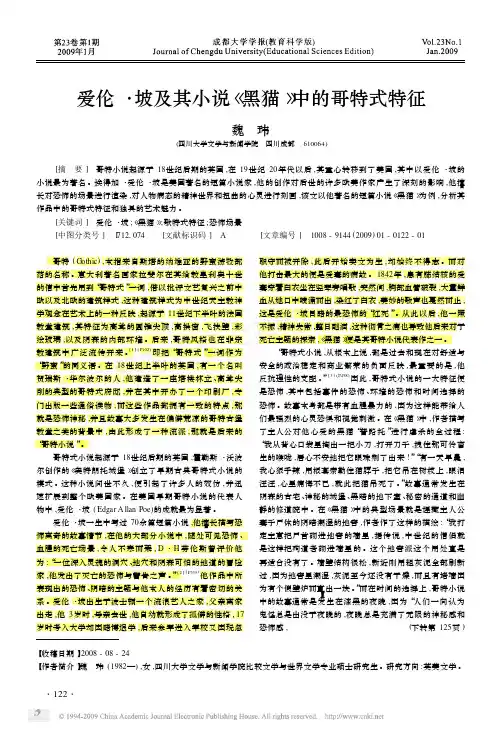
爱伦・坡及其小说《黑猫》中的哥特式特征魏 玮(四川大学文学与新闻学院 四川成都 610064)[摘 要] 哥特小说起源于18世纪后期的英国,在19世纪20年代以后,其重心转移到了美国,其中以爱伦・坡的小说最为著名。
埃得加・爱伦・坡是美国著名的短篇小说家,他的创作对后世的许多欧美作家产生了深刻的影响,他擅长对恐怖的场景进行渲染,对人物病态的精神世界和扭曲的心灵进行刻画,该文以他著名的短篇小说《黑猫》为例,分析其作品中的哥特式特征和独具的艺术魅力。
[关键词] 爱伦・坡;《黑猫》;歌特式特征;恐怖场景[中图分类号] I 7121074 [文献标识码] A [文章编号] 1008-9144(2009)01-0122-01 哥特(Gothic ),本指来自斯塔的纳维亚的野蛮游牧部削的典型的哥特式府邸,并在其中开办了一个印刷厂,专门出版一些通俗读物,而这些作品都拥有一致的特点,那就是恐怖神秘,并且故事大多发生在偏僻荒凉的哥特古堡教堂之类的背景中,由此形成了一种流派,那就是后来的“哥特小说”。
哥特式小说起源于18世纪后期的英国,霍勒斯・沃波尔创作的《奥特朗托城堡》创立了早期古典哥特式小说的模式。
这种小说问世不久,便引起了许多人的效仿,并迅速扩展到整个欧美国家。
在美国早期哥特小说的代表人物中,爱伦・坡(Edgar A llan Poe )的成就最为显著。
爱伦・坡一生中写过70余篇短篇小说,他擅长描写恐怖离奇的故事情节,在他的大部分小说中,随处可见恐怖、血腥的死亡场景,令人不寒而栗,D ・H 劳伦斯曾评价他为:“一位深入灵魂的洞穴、地穴和阴森可怕的地道的冒险家,他发出了灭亡的恐怖与警告之声。
”[2](P359)他作品中所表现出的恐怖、阴暗的主题与他本人的经历有着密切的关系。
爱伦・坡出生于波士顿一个流浪艺人之家,父亲离家出走,他3岁时,母亲去世,他自幼就形成了孤僻的性格,17岁时考入大学却因赌博退学,后来参军进入军校又因玩忽职守而被开除,此后开始卖文为生,却始终不得志。
浅析《红死病假面具》中哥特式小说风格作者:肖巧玲周逸轩来源:《赤峰学院学报·哲学社会科学版》2015年第11期摘要:哥特式小说属于英语文学派别,起始于18世纪下半期,是西方通俗文学中惊险神秘小说的一种。
埃德加·爱伦·坡的恐怖小说在颓废,怪诞和阴郁中透出幻觉般深邃的美,引起了世人的瞩目,他的作品都与自己自身的经历,个性气质以及当时的文坛主流有关。
本文以爱伦坡的小说风格的总评以及对其名作《红死病假面具》细节的分析,总结了《红死病假面具》中哥特式写作特点。
关键词:埃德加·爱伦·坡;哥特式小说;《红死病假面具》中图分类号:I712 文献标识码:A 文章编号:1673-2596(2015)11-0204-02一、引言哥特(Goth)一词最初来自于条顿民族中哥特部落的名称。
但是到了18世纪中后期,“哥特”成为一种新的小说体裁的名称。
这一类小说通常以古堡,废墟或者荒野为背景,经常出现幽灵鬼怪或者超自然现象,往往描写凶杀,暴力,复仇等内容,追求恐怖刺激的情节,充满悬念,笼罩着神秘,恐怖的气氛。
这种小说之所以被称为哥特小说,因其开山之作,贺拉斯的奥特龙多堡的副标题为一个哥特故事。
18世纪末,19世纪初哥特式小说在英国颇为流行,英国哥特小说的背景多为英国乡村,氛围永远神秘,恐怖,笼罩着超自然的色彩,给读者以一种恐惧好奇之感。
哥特式小说充满了狂热的想象力,超越现实的素材,超现实与现实相结合的手法使形式与激情内容完美统一。
爱伦坡在他戏剧性的40年间经历多次变故,不幸的童年和备受争议的婚姻,让爱伦坡总是能以与众不同的视角来观察他所生活的世界,作为侦探小说和恐怖小说的领军人物,爱伦坡在他的多部作品中展示了他所特有的哥特式风格。
《红死病假面具》小说的主人公王爷带领一千名壮士和美女隐居在一座城堡的寺院里,他们每天寻欢作乐,醉生梦死以躲避红死病瘟疫的侵害。
有一天,正当王爷举行一场化妆舞会时,一个全身裹着尸衣,血迹斑斑的陌生人突然出现。
外国文学研究 132《厄舍古屋的倒塌》的哥特体风格透析张守华 在文体类型多样化的短篇小说世界里,有一些传世之作往往能够魅惑几个世纪的读者,激发他们无尽的想象力。
作为生前无甚盛名、死后却影响极大的美国短篇小说家,爱伦・使这样一影响着后世”在这,情节与鬼魂、谋杀等奇闻相缠结;与此同时,它也展现了异邦情调,充满奇思异想,含有较多的神秘、恐怖、象征的成分,与现代派的表现手法不谋而合。
爱伦・坡的传记作家艾里克・卡尔森在《爱伦・坡》中曾说:“坡的创作生涯分为三个阶段:第一个阶段集中书写充满活力的浪漫传奇以及诗人的理想主义;第二个阶段是死亡和黑暗;第三个阶段又回归诗人、散文和虚构。
”[1]306正是在第二个阶段的死亡和黑暗的主题背景下,坡创作了优秀的虚构体短篇小说《厄舍古屋的倒塌》,而直到如今这个小说仍然颇受读者欢迎,它被认为是坡最好的作品。
一、环境氛围的哥特式情境小说以罗德里克・厄舍与儿时朋友,也即叙事者的重逢作为开始。
叙事者“我”去会见老朋友,看到了他们的居所———充满了恐怖意味的阴冷的老宅。
叙事人接下来进一步强化了老宅的这种阴郁的某些细节。
被引导进入主人的书房,叙事人“我”见到了他那无论在躯体还是在精神上都极为衰弱的朋友,在房子里还住着他的同胞妹妹马德琳,也同样患有和哥哥一样的精神疾病。
一天夜晚,罗德里克告诉“我”马德琳由于奇怪的病患,已经神秘地死亡,厄舍希望把她埋葬在古堡下的地窖里。
自那时起,罗德里克的精神状况越发恶化。
一个暴雨夜,叙事人正在给罗德里克念故事听,奇怪的、令人毛骨悚然的某种音响从古堡的深处传来,在“我”还未明白发生了什么,从地窖逃离的马德琳进入了房间,杀死了哥哥。
“我”在古堡沉没消失之前逃离了那个恐怖的厄舍古屋。
作者通过种种方式塑造了阴郁凄迷的环境,强化了小说本身的哥特式氛围。
首先,在整体环境的描写上,坡运用绘画般的手法,构筑了整个故事非常确切的背景。
这样就为整个小说定下了一个梦魇般的基调,在读者的心里挥之不去,影响着整部小说的阅读效果。
由语料库词汇检索析爱伦·坡的哥特风格爱伦·坡是19世纪末20世纪初美国文学史上最具影响力的作家之一,也是最重要的哥特风格作家之一。
哥特文学有独特的特征,它以惊险、悬疑甚至有点可怕的感觉来吸引读者,它使用古老的传说和神话作为背景,而其真正传达的是一种现实问题,即犯罪和人性中常有的矛盾。
在爱伦·坡的著作中,我们可以看到很多哥特风格的影子,她的作品融合了典型的哥特主题,如失落的世界、黑暗的景象、魔鬼般的角色和人性中的暗黑景象,这些都是哥特文学的典型特征。
爱伦·坡的作品涉及到不同的文化,尤其是古老的诸神故事,这些背景在她的作品中经常出现,也让故事充满了古老的气息,巧妙地增强了作品的兴趣度。
例如,在《拉尔夫与德姆西》中,主人公拉尔夫对他内心深处的传说故事情有独钟,他经常在特定的情况下自由地想象,联想到传说中的形象和属性,从而丰富了故事的情节。
另一方面,爱伦·坡通过神话可以说有某种传奇色彩,使得人们可以从中探索宇宙的奥秘,及其秩序如何在人类之间存在。
进一步来说,爱伦·坡对于《雅典娜传》也有一定的灵感,也就是她经常把死亡、古老的宗教信仰、神秘力量和女性主义主题融合到作品中,从而使故事充满了神秘感,有着强烈的哥特色。
总之,爱伦·坡的哥特风格是通过融合古老的神话故事和传说,并将之应用于现实世界的现实问题,将古老的神话色彩融入她的作品中去,塑造出神秘而具有惊险性的故事来引起读者的注意,从而体现出爱伦·坡的独特的哥特风格。
在爱伦·坡的作品中,这种传统的哥特风格从未失去其光芒,而是通过现代艺术的形式来表达,以及通过全新的艺术形式正在慢慢影响着今天的文学作品,让我们感受爱伦·坡对哥特文学的影响,以及给世界文化带来的巨大贡献。
爱伦坡和詹姆斯的哥特式小说比较陈韵姿吴鸿桃摘要:埃德加·爱伦坡和亨利·詹姆斯是美国19世纪两位著名的小说家。
哥特题材小说在二人的写作生涯中占据着重要地位。
本文以爱伦坡的小说《一桶白葡萄酒》和詹姆斯的小说《欢乐角》为例,对比二人哥特小说的风格。
关键词:哥特;爱伦坡;詹姆斯;《一桶白葡萄酒》;《欢乐角》一、作者简介埃德加·爱伦坡是美国19世纪著名诗人、小说家及文学评论家。
虽然爱伦坡以诗人的身份开始写作,但小说在其写作生涯中也占据着重要地位。
在他的短篇小说中,读者可以看到大量的哥特元素。
这类小说情节环环相扣,引人入胜,向读者展示了害人者和被害人同样承受的恐惧和痛苦,正如劳伦斯(D·H·Lawrence)所言,“他敲响了恐怖之钟,预示着他自己的厄运”。
[1]与爱伦坡生于同时代的亨利·詹姆斯被认为是继霍桑和麦尔维尔之后美国杰出的小说家。
因受豪威尔斯等作家的影响对文学产生兴趣,开始了写作生涯。
[2]由于詹姆斯深受欧洲文化的影响,于1875年定居欧洲,先在巴黎,后去了伦敦。
1915年他放弃美国公民身份加入英国国籍。
詹姆斯最擅长国际题材小说创作,哥特题材的作品在他的写作过程中并不占主导地位,但也是他文学创作的一个重要组成部分,在这类小说中詹姆斯将心理现实的写作手法巧妙地与哥特元素相融合,深入人物内心,赋予哥特小说新的意义。
二、比较《一桶白葡萄酒》和《欢乐角》《一桶白葡萄酒》是爱伦坡所写的一部恐怖短篇小说。
主人公蒙特利瑟因无法忍受弗图那多对自己的侮辱,所以决定实施复仇计划。
小说从头到尾都充斥着阴暗恐怖的气息。
与此相对应的是詹姆斯的小说《欢乐角》,主人公斯宾塞布莱恩33年后从欧洲返回纽约,纽约巨大的变化令他无法适应,在一个深夜,他亲眼见到了衣冠楚楚却面目狰狞的他我。
两篇小说以其独特的手法营造出一种哥特式的恐怖。
(一)哥特环境的比较传统的哥特小说在场景设计上主要以破败的古堡,迷宫般的地下通道、密室、墓穴和地牢为主。
文学评论·外国文学爱伦坡《黑猫》中采用的哥特式手法曲霞 沈阳师范大学摘 要:爱伦坡的小说是美国文学史上浓墨重彩的一笔,各种题材的小说他均有涉猎,而其中悬疑和恐怖小说则是他最擅长的两种题材。
在此基础上分析爱伦坡小说《黑猫》中的哥特式元素。
关键词:写作手法;哥特式元素;悬疑;恐怖作者简介:曲霞(1997-),女,汉族,辽宁大连人,沈阳师范大学英语师范专业2014级本科生,研究方向:美国文学。
[中图分类号]:I106 [文献标识码]:A[文章编号]:1002-2139(2017)-17-139-01爱伦坡的黑猫讲述的是一个恐怖,神秘,暴力,超自然的有关死亡的小说。
这部小说虽然短小,但是在精简的文字中充斥着哥特式元素。
一、哥特式小说特点分析1.哥特式小说概念哥特式(Goth)最早是文艺复兴时期被用来区分中世纪时期(公元5-15世纪)的艺术风格,以恐怖、超自然、死亡、颓废、巫术、古堡、深渊、黑夜、诅咒、吸血鬼等为标志性元素。
哥特式风格用黑暗、恐惧、孤独、绝望的艺术主题,来往于内心世界神圣与邪恶的边缘,描绘在爱与绝望之间的挣扎,嘶叫的痛苦和清醒。
2.《黑猫》中的哥特式元素刑事被害人是指正当权利或合法利益遭受犯罪行为直接侵害的人,是犯罪危害结果的直接承担者。
既然被害人是犯罪危害结果的直接承担者,为了及时、有效的保护和修复那些被犯罪行为侵害的正当权利或合法权益,法律必须赋予被害人必要的权利,那么被害人的权利具体应该包括那些呢?二、爱伦坡如何在小说中运用哥特式元素1.主人公的情感变化爱伦坡对于主人公性格善恶对比来体现哥特式特征。
“我”小的时候是一个性情温良,喜欢动物的人,特别在与动物相处的一举一动都会使主人公享受到快乐,甚至在小的时候因为性情温顺和而出名。
而这一点在“我”长大之后并没有改变,结婚后他和妻子志趣相投,养了很多动物,也包括那只黑猫。
值得一提的是,“我”特意提到迷信妻子的一句话:“所有的黑猫都是女巫伪装的”[1]。
评爱伦.坡《一桶白葡萄酒》的哥特式特征哥特小说是18世纪末、19世纪初在英国广为流行的小说形式,以表现神秘、恐怖为主要特征,题材多以中世纪爱情生活及家族纷争为主。
其名称来源与哥特式建筑有关:18世纪后半叶,英国哥特式建筑复兴,当时的贵族国会议员贺拉斯?华尔浦尔(Horace Walpole)在伦敦附近建一哥特式城堡,并在此自办印刷所,出版作品。
1764年,他出版了自己创作的中篇小说《奥特朗托城堡》,讲述了12、13世纪时期曼弗雷德霸占奥特朗托城堡后遭报应的故事。
因其创作出版的此类小说即在其哥特式城堡内,加之此类小说又与中世纪野蛮、血腥行为有关,所以此类小说被称为哥特小说,而《奥特朗托城堡》则被视为此类小说的第一部。
随后,安娜?拉德克利夫(Ann Radcliffe)的《尤道弗的神秘踪迹》(1974)和《意大利人》(1979),以及马修?刘易斯(Matthew Lewis)的《修道士》(1796)三部流行小说统治文坛,成为无可争议的哥特小说的经典之作,并影响了其他一些国家,特别是德国和美国的文学创作。
哥特小说通常以旧时(往往是中世纪)偏僻、破败的城堡、废墟或荒野为背景,极力表现的是那些场所里发生的离奇故事给人物的感情和性格所带来的影响,其中充斥着暴力、凶杀、复仇、强奸、乱伦以及阴郁、恐怖和神秘的气氛,并且时常还有鬼怪精灵或奇异的超自然现象穿插其中,令人毛骨悚然。
19世纪20年代以后,哥特小说在美国迅速发展和繁荣,并日趋内在化、心理化。
而使哥特小说朝内在化方面发展最突出的作家就是爱伦?坡。
爱伦?坡是美国文学史上独树一帜的作家,他在19世纪美国文学的发展中占有特殊的地位。
与同时代的小说家相比,爱伦?坡有许多与众不同之处。
其中最主要的方面之一是:他既拥有自己较为系统的创作理论,又能够将其理论付诸于创作实践并取得了非凡的成就。
按照坡的理论,小说应着力展示人的内心世界,尤其是人格中以往被忽视的病态或者阴暗的一面,而且叙事要简洁明了,力争使故事以较快的节奏发展到高潮,以便产生某种单一的预期效果。
最新英语专业全英原创毕业论文,都是近期写作1 英文电影欣赏与大学生跨文化交际能力的培养——xx学院案例2 从跨文化交际角度看中西方商务谈判3 从《麦琪的礼物》看欧亨利的写作手法4 英汉语篇中的省略衔接手段对比及其翻译方法——以《雪》译文为例5 网络语言风格的性别差异6 如何提高学生的自主学习能力7 《喜福会》中的中美文化冲突8 着魔的猎人——解读《洛丽塔》中的男主人公亨伯特9 工业化进程下人的主体性的追问——梭罗的《瓦尔登湖》10 《汤姆叔叔的小屋》中圣克莱尔一家的人物分析11 关于鲁宾逊的精神分析12 Modern Views on Marriages in Wuthering Heights13 A Brief Analysis of the Main Female Characters in Golden Notebook14 《看不见的人》中的“暗与明”意象探究15 从礼仪角度谈中西文化的差异性16 The French Revolution in the Novel A Tale of Two Cities17 从概念隐喻看寓言的语篇连贯18 英汉同义词对比及翻译19 澳大利亚文学中的丛林文化—以亨利•劳森《赶牲畜人的妻子》为例20 中西方关于萨达姆之死新闻报道的批评性话语分析21 文本分类理论与广告翻译22 《鲁滨逊漂流记》的后殖民主义解读23 中国英语与中式英语之比较24 On the Functions of Metaphor in Obama’s Inaugural Address25 以目的论为指导的化妆品商标翻译26 女性意识的觉醒——评《雨中的猫》中的人物对比描写27 奈达功能对等理论指导下英汉广告修辞的翻译策略探究28 汉语中的英语外来语29 《冰与火之歌》的人文主义分析30 清代以来中西文化交流对中国婚俗的影响31 英汉语篇衔接手段对比研究——以《荷塘月色》英译本为例32 英语委婉语及其语用学原则33 名词化隐喻在外贸函电中的功能分析34 广告中的文化差异及翻译策略35 通过《蝇王》看人性36 从功能派翻译理论的角度看商标名称的英译37 论《月亮宝石》的现实主义手法38 日用品广告语言中中西方价值观差异比较研究39 比较《简爱》中女性“陈规形象”与《飘》中女性“新形象”40 从目的论看电影《音乐之声》中对白的汉译41 An Interpretation of Rebecca’s dual Personality42 从目的论角度看公司网页误译43 跨文化交际中的障碍浅析及其解决方法44 A Journey through Harsh Reality: Reflections on Gulliver’s Travels45 论《荆棘鸟》中人性和宗教信仰的矛盾冲突46 英语课堂合作学习策略研究47 不同IT企业官网英译现状调查48 “It be Adj of sb to do sth”中形容词语义的构式语法研究49 An Analysis of the Names in Tess of the d’Urbervilles50 从《艾玛》看简奥斯汀小说中的对话运用51 An Ecocritical Analysis on Lady Chatterley’s Lover52 《简爱》中女性主义之探究53 杰克•伦敦《野性的呼唤》中人生哲学的主题分析54 以篱笆和围墙看中西方居住文化差异55 浅析《不存在的人》中主人公的觉醒56 A Brief Study of the Causes o f Emily’s Tragedy in A Rose for Emily57 不伦,还是不朽?--从柏拉图的哲学理论视角解读《洛丽塔》58 英语习语汉译方法浅析59 中英社交禁忌习俗异同之比较分析60 [毕业论文](日语系毕业论文)关于中日赞赏语的比较研究61 从《大卫科波菲尔》的女性人物塑造看现实主义与浪漫主义的结合62 An Analysis of Communicative Language Teaching Method in Teaching Spoken English in China63 Pragmatic Empathy and Chinese-English Translation64 从《红楼梦》和《飘》看中美恭维语比较65 自我效能感对大学生英语学习的影响66 试析《我知道笼中鸟为何歌唱》的成长主题67 Grammatical Analysis of Academic Writing68 英语阅读现状分析及对策69 阅读中的英语词汇教学策略70 中英文化差异对成语翻译的影响71 A Study of Pragmatic Functions of Fuzzy Language in English Advertisements72 东西方文化中团队意识的差别73 从社会语用学角度分析《雷雨》中的称谓语74 从《老人与海》看海明威小说中的英雄式人物的刻画75 新课标指导下的中学英语语法教学76 浅析英语广告中双关语的语用功能77 英语专业新生英语阅读习惯调查78 从《喜福会》看美国华裔女作家身份探求79 谈呼啸山庄的复仇主题80 多媒体技术在英语语境教学中的应用81 译员主体性在歌曲《我有个梦》歌词翻译中的体现82 中学英语教师课堂反馈对学生焦虑的影响83 词汇和背景知识对英语阅读理解的重要影响及应对策略84 《隐形人》中主人公的性格分析85 论《小妇人》的叙事技巧86 跨文化因素对字幕翻译的影响87 回译在翻译教学中的作用88 中外大学校训翻译分析89 高中英语教学中跨文化心理学的研究90 汽车广告翻译浅析---论消费者心理差异对汽车广告翻译的影响91 《莫比迪克》中不同的人物特点92 中国跨文化交际学研究存在的不足与建议93 析《虹》中的象征意义94 中美拒绝策略研究95 Which Woman is More Popular in Modern Society:A Comparative Study of Tess and Jane96 论《了不起的盖茨比》中的象征及其作用97 从翻译审美分析食品品牌名称翻译的原则及策略98 On the Application of Modernism in Creating the Inner World of Laura in The Garden Party99 《红楼梦》中的数字翻译及其文化分析100 《看不见的人》的象征意义101 英汉颜色词文化内涵的异同分析102 《十日谈》中的乡村意象103 从后殖民主义看《贫民窟的百万富翁》的成功104 试论霍桑小说《胎记》中的象征主义105 《夜访吸血鬼》中的模糊性别观106 A Study on Theme Slogan Translation—from the Perspective of Functional Equivalence Theory107 对罗伯特•弗罗斯特自然诗的尝试性研究108 换位思考在商务信函中坏消息的运用及建议109 意象创造的对比研究——文化视觉下的中英文诗歌110 解读奥斯丁小说《诺桑觉寺》对哥特传统的模仿与颠覆111 形合与意合对比研究及翻译策略112 在英语口语教学中提高学生跨文化交际能力113 安妮•赖斯小说《夜访吸血鬼》的新哥特世界114 中西方聚会文化差异比较研究115 Exploring Effective Approaches to Translating Allusion in Ancient Chinese Poetry116 由女性“奴性”潜意识解析玛利娅姆多舛命运117 论英汉谚语的起源差异118 The Postmodern Story In the Victorian Age--The French Lieutenant's Woman119 Coincidences and Images in The Mayor of Casterbridge, Tess of the D’Urbervilles120 The Loss and Gain in Classical Chinese Poetry Translation121 《老人与海》和《热爱生命》的生态比较122 从合作原则看《傲慢与偏见》中的会话含义123 论谭恩美小说《喜福会》中的母女关系124 从模因论角度研究中文新闻标题中的流行语125 Growing Pains—An Analysis of J. D. Salinger’s The Catcher in the Rye as a Bildungsroman 126 从依恋理论看《呼啸山庄》主人公希斯克利夫悲剧性格的形成(开题报告+论)127 英语中天气隐喻的认知解读128 从功能分析的角度试析广告英语中语言的性别差异129 青少年的心理发展特点—从心理学角度解析《麦田里的守望者》130 海丝特白兰—清教时代的新女性131 从《所罗门之歌》看美国的黑人文化132 浅论《儿子与情人》中劳伦斯的心里分析技巧133 从翻译等值理论看文化词的翻译134 受超验主义影响的具有美国精神的作家135 Contradiction of Hawthorne Reflected in the Symbols and Images in Young Goodman Brown 136 思维差异对中美商务谈判的影响及应对策略137 《麦田里的守望者》的文体特色分析138 浅谈汉英时间隐喻的文化异同139 A Comparative Study on the Symbolic Meanings of Color Red Between The Scarlet Letter and Tess of the D’Urbervilles140 浅析商务谈判中非言语交际的核心地位141 影响高中学生英语学习兴趣因素的调查及分析—以x市高中学生为调查对象142 《愤怒的葡萄》中圣经的象征和隐喻143 文明的樊笼—解读《野性的呼唤》144 从《大卫科波菲尔》女性人物形象分析来看狄更斯以女性为中心的家庭观145 肢体语言在大学英语教学课堂中的应用146 Whose Portrait Is This—Exploring Oscar Wilde’s Complex Personality147 解读《儿子与情人》中保罗的俄狄浦斯的影响148 中西饮食文化的对比149 中国纺织业出口现状和对策150 影响英语阅读理解效率的非语言因素151 从文化角度论英文商标名称的翻译152 《茶馆》英译本的翻译对比研究153 英汉植物词文化内涵的比较研究154 外贸企业的汇率风险规避155 商务英语的特点及翻译技巧156 从饮食角度透析中西方文化差异157 从社会符号学角度浅谈汉语“一”字成语翻译158 论莱辛作品《又来了,爱情》中妇女失爱的原因159 比较分析《野草在歌唱》与《倾城之恋》中女性的爱情婚姻观160 论《简爱》中的经济意识161 基于认知的颜色词隐喻研究162 从《蝴蝶夫人》到《蝴蝶君》的蜕变163 解析《麦田里的守望者》中帽子和鸭子的象征意义164 对美国总统就职演说的文体分析165 《鲁滨逊漂流记》中鲁滨逊的资产阶级特征166 分析《天使,望故乡》的精神主题167 意译在广告英语翻译中的重要性探析168 解读《哈利•波特》中纳西莎•马尔福的形象169 论英美文学作品中的人名寓意及翻译170 跨文化商务谈判中的文化差异及应对技巧171 解析电影《黑暗骑士》中的美国个人英雄主义172173 论《傲慢与偏见》中的性别语言差异174 Current Status of Adverse Drug Reaction Monitoring System in China175 试论金融英语词汇的特点与翻译176 英汉恭维语语用对比研究177 从《鲁宾逊漂流记》看性格对命运的影响178 爱米丽的挣扎与终结——论《献给爱米丽的一朵玫瑰花》中爱米丽毁灭的间接和直接原因179 论戏剧《威尼斯商人》中夏洛克的悲剧形象180 礼貌原则在口译中的应用181 分析《嘉莉妹妹》中女主角嘉莉妹妹命运转变的原因182 从《少年派的奇幻漂流记》论人性与兽性183 对比不同思维方式下事物的中英文描述差异184 女性主义翻译研究——《简•爱》两种中文译本的比较185 浅析简•爱的反抗性格及其形成过程186 《查特莱夫人的情人》中肉体与灵魂的平衡187 《到灯塔去》中的“双性和谐”研究188 Exploration of Dickens’ Humanitarianism in Great Expectations189 跨文化交际中旅游英语菜式的翻译190191 英语政治新闻中委婉语的形式及语用功能研究192 A Feminist Study of William Shakespeare’s As You Like It193 Comparison and Translation Between Chinese and English Euphemisms194 威廉•麦克佩斯•萨克雷《名利场》的道德研究195 从功能对等角度看信用证英语的翻译196 Resonant Effect of Dialogues in Lolita on Readers197 Tragic Elements——An analysis of the protagonist Holden’s growth experience in The Catcher in the Rye198 浅谈商标的特点及其翻译199 论爱伦坡小说中的哥特式风格200 英汉“悲”、“喜”情感隐喻的认知比较研究。